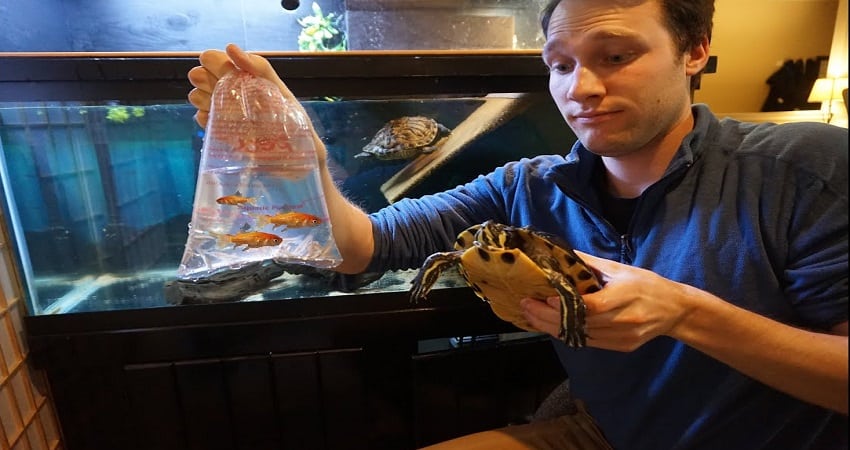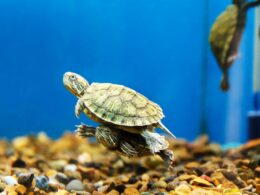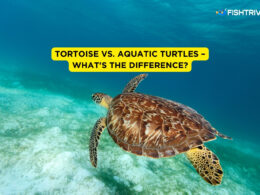In this article Show
Turtles have a setup that enables them to survive in an aquarium. The structure includes; lighting conditions, filtration, and aquarium conditions. The majority of the people placed the turtles with their mates.
Placing turtles together with fish can be good at times and harmful at other times. If you wish to place the turtles and fish together, seek advice from an aquarist but if not, avoid putting the species together.
This article summarizes factors to consider when placing turtles together with fish. Also, it shows you must avoid putting fish with turtles, such as Zebrafish, and others, such as goldfish.
Also worth reading;
- Tortoise vs. Aquatic Turtles – What’s The Difference?
- Axolotl & Turtle – Can You Keep Them Together?
- African Butterfly Fish Care: Tank Mates, Feeding, Breeding & More
Is It OK To Keep Fish In Your Turtle Tank?
Yes, to put it succinctly. In your turtle aquarium, you can keep fish. Fish and turtles can coexist peacefully if the appropriate fish turtle and use the environment. Below are things to think about and some of the species that operate best in turtle environments.
Consider These Factors When Selecting Turtle Companion
Before selecting a turtle companion here are a few things to put into consideration;
1. Tank requirements
It’s critical that your tank’s inhabitants like similar environmental circumstances, such as temperature and water quality. If the residents of your tank are from various settings, they may suffer from stress, disease, or even death.
The majority of turtles prefer water temperatures between 72 and 800 degrees Fahrenheit (F). Many freshwater fish prefer a much warmer temperature range.
When you mix turtles and fish, water quality becomes a significant issue. Due to their frequent expulsions and untidy eating habits, turtles have a high bioload.
Due to their activities, turtles are generally durable and able to flourish in various water conditions, whereas most fish are not. If you want to keep fish in your turtle tank, you’ll need a filter that can handle both the turtle and the fish’s bioload.
2. Turtle Populations
The majority of turtles are omnivores, meaning they consume both plants and animals. The most straightforward approach to keep your fish safe from turtle predation is to keep it in the tank until your turtle is fully grown.
When they’re young, most turtles are carnivorous, but they adapt to a nearly vegetarian diet as adults. Adult turtles are less likely to consume your fish as a result.
3. Areas to Hide
It’s crucial to have decorations in a turtle tank before adding fish to help both the turtle and the fish adjust. Consider placing decorations or plants in the tank to help break up the lines of sight.
This will aid in the de-escalation of difficult circumstances and provide the tank’s inhabitants with a sense of seclusion when needed. If you’re going to have smaller fish in your tank, having spots that your fish can access, but your turtle can’t be advantageous.
4. Dimensions of the Aquarium
If you’re introducing new species to your aquarium, make sure you have enough space in the tank for them to have their own space.
You’re more prone to have aggressive confrontations between your tank residents if your tank is too small.
If you’re adding any animal to your turtle tank, the aquarium should be at least 80 gallons. Turtles need 10 gallons of water for every inch of shell length, while most fish need at least a gallon per inch of length.
5. Fish Populations
Choose a fish species less likely to be eaten when choosing a fish for your turtle tank. You have two options for achieving this. The first choice is to select a fish that is either too large or too tough to consume. Choose a fish that is too fast and aggressive for your turtle to catch.
Best Companions For Turtles
Here are the best companions for turtles;
1. Pictus catfish
Angel Cats, commonly known as Pictus Catfish, are white and black catfish with massive barbels and lively dispositions.
Pictus Catfish are fast swimmers that grow to be 5 inches long, making them small enough to cohabit comfortably with turtles.
Pictus Catfish have sharp spines on their fins, so use caution when introducing them to your aquarium. Although these spines can hurt your turtle’s fragile skin, just one poke will teach your turtle to respect its personal space.
2. Zebrafish
Another little fish that gets along nicely with turtles is the Zebrafish, often known as Zebra Danios. Zebrafish, like Tetras, is swift and loud fish that can effectively dodge (and even harass) your turtle.
Because they are schooling fish, it is better to add them in groups of 6-7 people. Though ZebrafishZebrafish prefers temperatures between 65 and 77 degrees Fahrenheit, they can survive in a wide variety of temperatures and thrive in the warmer turtle habitat.
3. Tetra fish
Tetra fish are colorful, lively, tiny fish that prefer to live in small groups. They like temperatures between 75 and 80 degrees Fahrenheit, just like turtles, and are relatively resistant to fluctuations in water quality. Tetras are excellent turtle companions because they are inexpensive to buy and are typically too swift and intelligent for a turtle to catch
4. Suckermouth catfish
Suckermouth Catfish, also known as Plecostomus, is one of the easiest turtle species to keep and one of our favorites. Suckermouth Catfish like water temperatures between 72 to 86 degrees Fahrenheit, but they can survive in almost any situation.
Suckermouth Catfish can reach 20 inches and have armor-like scutes covering their upper body and head. As a result, Suckermouth Catfish are usually too big to consume but tough enough to survive in a turtle’s environment. However, their size necessitates the use of a larger tank.
5. Koi fish
For turtles raised in larger, outside ponds, koi are an excellent choice. Koi are a calm carp species that can reach a length of 36 inches. Turtles may eat young koi, but juveniles and adults are much too big to be mistaken for food. Koi comfortably coexist with most turtle species if you have a large enough room for them.
6. Other turtles
A turtle of the same species or a different species might be a terrific buddy for your turtle. To reduce aggressive behavior, introduce fresh turtles under the correct settings.
When numerous turtles are present, there is a risk of damage, maiming, or death from fighting. To avoid this, make sure that each turtle you add fits the following criteria:
- The age and size of turtles in the same tank must be similar.
- Make sure there are enough water and sunbathing spots for all of the turtles.
- If you have three or more turtles of the same species, make sure the female turtles outnumber the males. Males will frequently fight in situations where there are more males than females.
- Make sure the two species can cohabit if you’re introducing a new species. Snapping turtles and softshell turtles, for example, are territorial and should always be kept together.
Companions for Turtles to Avoid
Turtles, like every other species, have a few fish that they don’t get along with. It’s preferable to avoid fish with the following traits when choosing a fish for your turtle habitat.
Fish that are overly aggressive or have the potential to harm, maim, or kill your turtle. Giant catfish, piranhas, electric eels, lobsters, and Oscars are just a few examples;
1. Betta fish
Because of their aggressive natures, keep Betta fish alone. This independence, along with their beautiful hues, makes them appear to be the ideal turtle partner. Betta fish quickly take on the nature of their names when kept with turtles. Betta fish are easy prey for hungry turtles because of their vivid colors, long, flowing fins, and languid movements.
2. Goldfish
Goldfish are one of the most popular turtle tank fish, but they come with their own set of problems.
As previously said, aquarium size and tank conditions are two of the most significant variables to consider when selecting a buddy. When it comes to goldfish, however, both of these variables fall short:
Goldfish are indeterminate growers, which means they will continue to grow indefinitely. This, paired with their lengthy lifespans (10-15 years) and rapid reproductive rate, allows them to overwhelm a tank quickly.
Goldfish, like turtles, have bioloads that considerably outweigh their size. Your turtles and goldfish will combine to produce amounts of ammonia that are unhealthy for all species involved unless you have a powerful filtration system and are ready to put in additional maintenance hours.
Furthermore, goldfish are cold-water fish that require temperatures of about 74 degrees Fahrenheit. You must then either make the water too warm for goldfish or too chilly for turtles in a tank with goldfish and turtles. In either case, one of your tank’s residents develops stress.
Conclusion
Fish and turtles may be housed together depending on the type of fish and other factors such as water conditions, food, and size of the tank, among others.
Despite them being housed together, according to my own opinion, it is a bad idea because some turtles may harm fish, or some fish may harm other turtles, especially the young ones.
But if you wish to keep the turtles and the fish together, consider some precautions such as; not housing both young and adult turtles and fish together, avoiding placing both species in a small tank and finally seeking help from an aquarist.










